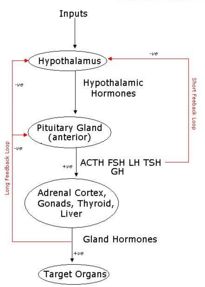Negative Feedback - Anatomy & Physiology
|
|
Negative Feedback Loops
The endocrine system has the ability to self-regulate, with Negative Feedback being the most commonly utilised mechanism.
In negative feedback control, increased activity of a target organ creates signals which reduce the activity of that organ, and vice versa.
This maintains the activity within normal limits, resulting in appropriate homeostasis.
It is important to understand how the 'axis' of the endocrine system work. In simple terms, the Hypothalamus secretes a hormone which acts on the Pituitary Gland to secrete a second hormone. This acts on a gland initiating secretion of a third hormone:
At each level there is feedback.
Short Feedback Loop
This involves the Hypothalamus and Pituitary Gland. The Hypothalamus secretes a hormone, causing the pituitary to secrete a hormone in response. This hormone then reduces the signal from the hypothalamus.
Long Feedback Loop
This occurs where the hormone from the target organ/gland acts on the Hypothalamus (and sometimes the Pituitary) reducing their hormonal signals.
